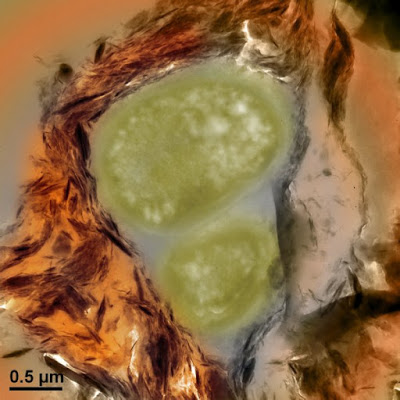
Microbes are essential to life on Earth. They’re found in soil and water and inside the human gut. In fact, nearly every habitat and organism hosts a community of microbes, called a microbiome. What’s more, microbes hold tremendous promise for innovations in medicine, energy, agriculture, and understanding climate change.
Scientists have made great strides learning the functions of many microbes and microbiomes, but this research also highlights how much more there is to know about the connections between Earth’s microorganisms and a vast number of processes. Deciphering how microbes interact with each other, their hosts, and their environment could transform our understanding of the planet. It could also lead to new antibiotics, ways to fight obesity, drought-resistant crops, or next-gen biofuels, to name a few possibilities.
To understand and harness the capabilities of Earth’s microbial ecosystems, nearly fifty scientists from Department of Energy national laboratories, universities, and research institutions have proposed a national effort called the Unified Microbiome Initiative. The scientists call for the initiative in a policy forum entitled “A unified initiative to harness Earth’s microbiomes” published Oct. 30, 2015, in the journal Science.
The Unified Microbiome Initiative would involve many disciplines, including engineering, physical, life, and biomedical sciences; and collaborations between government institutions, private foundations, and industry. It would also entail the development of new tools that enable a mechanistic and predictive understanding of Earth’s microbial processes.
Among the authors of the Science article are several scientists from the Department of Energy’s Lawrence Berkeley National Laboratory (Berkeley Lab). These are Berkeley Lab Director Paul Alivisatos; Eoin Brodie, Deputy Director of the Climate and Ecosystem Sciences Division; Mary Maxon, the Biosciences Area Principal Deputy; Eddy Rubin, Director of the Joint Genome Institute; and Peidong Yang, a Faculty Scientist in the Materials Sciences Division. Alivisatos is also the Director of the Kavli Energy Nanoscience Institute, and Yang is the Co-Director.
Berkeley Lab has a long history of microbial research, from its pioneering work in metagenomics at the Joint Genome Institute, to the more recent Microbes to Biomes initiative, which is designed to harness microbes in ways that protect fuel and food supplies, environmental security, and health.
The call for the Unified Microbiome Initiative comes at a critical time in microbial research. DNA sequencing has enabled scientists to detect microbes in every biological system, thriving deep underground and inside insects for example, and in mind-boggling numbers: Earth’s microbes outnumber the stars in the universe. But to benefit from this knowledge, this descriptive phase must transition to a new phase that explores how microbial communities function, how to predict their actions, and how to make use of them.
“Technology has gotten us to the point where we realize that microbes are like dark matter in the universe. We know microbes are everywhere, and are far more complex than we previously thought, but we really need to understand how they communicate and relate to the environment,” says Brodie.
“And just like physicists are trying to understand dark matter, we need to understand the functions of microbes and their genes. We need to study what life is like at the scale of microbes, and how they relate to the planet,” Brodie adds.
This next phase of microbiome research will require strong ties between disciplines and institutions, and new technologies that accelerate discovery. The scientists map out several opportunities in the Science article. These include:
- Tools to understand the biochemical functions of gene products, a large portion of which are unknown.
- Technologies that quickly generate complete genomes from individual cells found in complex microbiomes.
- Imaging capabilities that visualize individual microbes, along with their interactions and chemical products, in complex microbial networks.
- Adaptive models that capture the complexity of interactions from molecules to microbes, and from microbial communities to ecosystems.
Many of these new technologies would be flexible platforms, designed initially for microbial research, but likely to find uses in other fields.
Ten years after the launch of the Unified Microbiome Initiative, the authors of the Science article envision an era in which a predictive understanding of microbial processes enables scientists to manage and design microbiomes in a responsible way–a key step toward harnessing their capabilities for beneficial applications.
“This is an incredibly exciting time to be involved in microbial research,” says Brodie. “It has the potential to contribute to so many advances, such as in medicine, energy, agriculture, biomanufacturing, and the environment.”
Video
Microbes power our planet’s biogeochemical cycles, provide nutrients to our plants, purify our water and are integral components in keeping the human body free of disease and may hold to the Earth’s future.
Reference:
A. P. Alivisatos, M. J. Blaser, E. L. Brodie, M. Chun, J. L. Dangl, T. J. Donohue, P. C. Dorrestein, J. A. Gilbert, J. L. Green, J. K. Jansson, R. Knight, M. E. Maxon, M. J. McFall-Ngai, J. F. Miller, K. S. Pollard, E. G. Ruby, S. A. Taha. A unified initiative to harness Earth’s microbiomes. Science, 2015; 350 (6260): 507 DOI: 10.1126/science.aac8480
Note: The above post is reprinted from materials provided by DOE/Lawrence Berkeley National Laboratory.










